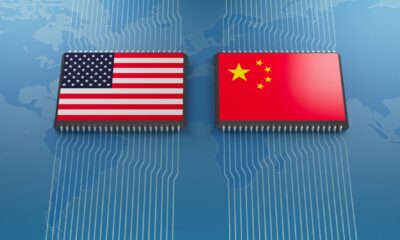China
Rural underemployment threatens China’s growth

Authors: Scott Rozelle, Stanford University and Dorien Emmers, KU Leuven
According to World Bank data, only a handful of economies have risen from middle- to high-income status since 1960, when economic catch-up growth in many developing economies took off. Examples include South Korea, Singapore, Israel and Ireland. Some countries that were high income in 1960 remain so today, such as Denmark and Japan. Others, like Myanmar and North Korea, have stayed poor. Many countries have stayed at middle-income status for decades, seemingly unable to reach high-income status. How does China compare to these other countries stuck at the middle-income level?
One key factor that may account for the disparate development paths of countries is education. According to the OECD, in 2015 the average share of workers — people aged 18–65 — that completed secondary education in countries that graduated to high-income status was 72 per cent when they were still at middle-income status. But in countries that have failed to exit middle-income status the share is much lower — 36 per cent on average.
Having a large supply of educated workers ensures that enough talent exists to meet and drive demand for high value services, thereby sustaining growth. When too many unskilled workers are squeezed out of upgraded industries their wages stagnate, curtailing demand and hampering growth. This eventually leads to serious social problems, such as higher rates of unemployment and increased crime and social unrest.
Education attainment metrics help reveal China’s potential future development and growth trajectory. The share of uneducated workers in China’s labour force is larger than that of virtually all middle-income countries. According to 2010 census data, there are roughly 500 million people in China between the ages of 18 and 65 without a senior high school diploma, which is 74 per cent of the labour force. This makes China the least educated middle-income country in the world.
A large population of uneducated workers was not a problem when China moved from low- to middle-income status. Unskilled wages were low and there was growth in low-cost manufacturing and construction. But China’s growth model is changing as it becomes wealthier. Unskilled wages are much higher but the lure of cheaper labour elsewhere and China’s massive push to automate is rendering low-skilled workers redundant. Construction jobs have tapered off as investment in infrastructure cools. These factors suggest China’s unskilled workers may be increasingly unemployable as the economy upgrades.
The only destination for China’s unskilled workforce — whether new entrants to the labour force or laid-off workers — is the informal service sector. Data from the 2018 China Statistical Yearbook shows that informal employment is currently the fastest growing sector in China, increasing from 33 per cent in 2004 to 56 per cent in 2017. This rising supply of workers has ushered in stagnating wages for unskilled workers. Meanwhile, strong demand for skilled work means higher wages are going to those with an education. The result may come to resemble Mexico, where solid macroeconomic performance, export success and an accumulation of physical capital has not translated into growth in the formal economy.
Recognising the critical need for secondary education, China’s government has expanded access to high school throughout the country. High school attainment among the youngest cohorts in the labour force is close to 80 per cent. But hundreds of millions of less educated people will remain in the labour force for the next 30 years. The government will face huge challenges trying to either retrain workers or provide a social safety net.
The quality of China’s expanded secondary school education is also uncertain. Almost all low-skilled labour comes from rural areas where school and health systems are under-resourced. Many of China’s new secondary school graduates attended poor quality vocational schools. Systemic shortfalls in early childhood education and health in rural areas may also render many young people unprepared to learn complex skills as they age. A systematic review and meta-analysis found that 45 per cent of children in rural schools across China have delayed cognitive development before they reach the age of five.
Investments during the first years of life in a safe home environment with sufficient learning opportunities, healthy nutrition and responsive caregiving are crucial for healthy child development. But a study published in 2017 on…
China
China’s GDP Grows 5% in 2024: Key Insights and Main Factors

In 2024, China’s GDP grew by 5.0%, meeting its annual target. The fourth quarter saw a 5.4% increase, driven by exports and stimulus measures. The secondary industry grew 5.3%, while the tertiary increased by 5.0%, totaling RMB 134.91 trillion.
China’s GDP grew by 5.0 percent in in 2024, meeting the government’s annual economic target set at the beginning of the year. Fourth-quarter GDP exceeded expectations, rising by 5.4 percent, driven by exports and a flurry of stimulus measures. This article provides a brief overview of the key statistics and the main drivers behind this growth.
According to official data released by the National Bureau of Statistics (NBS) on January 17, 2025, China’s GDP reached RMB 134.91 trillion (US$18.80 trillion) in 2024, reflecting a 5.0 percent year-on-year growth at constant prices. During the 2024 Two Sessions, the government set the 2024 GDP growth target of “around 5 percent”.
By sector, the secondary industry expanded by 5.3 percent year-on-year to RMB 49.21 trillion (US$6.85 trillion), the fastest among the three sectors, while the tertiary industry grew by 5.0 percent, reaching RMB 76.56 trillion (US$10.63 trillion) and the primary industry contributed RMB 9.14 trillion (US$1.31 trillion), growing 3.5 percent.
A more detailed analysis of China’s economic performance in 2024 will be provided later.
(1USD = 7.1785 RMB)
| This article was first published by China Briefing , which is produced by Dezan Shira & Associates. The firm assists foreign investors throughout Asia from offices across the world, including in in China, Hong Kong, Vietnam, Singapore, and India . Readers may write to info@dezshira.com for more support. |
Read the rest of the original article.
China
Can science be both open and secure? Nations grapple with tightening research security as China’s dominance grows

The U.S.-China science agreement renewal narrows collaboration scopes amid security concerns, highlighting tensions. Nations fear espionage, hindering vital international partnerships essential for scientific progress. Openness risks declining.
Amid heightened tensions between the United States and China, the two countries signed a bilateral science and technology agreement on Dec. 13, 2024. The event was billed as a “renewal” of a 45-year-old pact to encourage cooperation, but that may be misleading.
The revised agreement drastically narrows the scope of the original agreement, limits the topics allowed to be jointly studied, closes opportunities for collaboration and inserts a new dispute resolution mechanism.
This shift is in line with growing global concern about research security. Governments are worried about international rivals gaining military or trade advantages or security secrets via cross-border scientific collaborations.
The European Union, Canada, Japan and the United States unveiled sweeping new measures within months of each other to protect sensitive research from foreign interference. But there’s a catch: Too much security could strangle the international collaboration that drives scientific progress.
As a policy analyst and public affairs professor, I research international collaboration in science and technology and its implications for public and foreign policy. I have tracked the increasingly close relationship in science and technology between the U.S. and China. The relationship evolved from one of knowledge transfer to genuine collaboration and competition.
Now, as security provisions change this formerly open relationship, a crucial question emerges: Can nations tighten research security without undermining the very openness that makes science work?
Chinese Premier Deng Xiaoping and American President Jimmy Carter sign the original agreement on cooperation in science and technology in 1979.
Dirck Halstead/Hulton Archive via Getty Images
China’s ascent changes the global landscape
China’s rise in scientific publishing marks a dramatic shift in global research. In 1980, Chinese authors produced less than 2% of research articles included in the Web of Science, a curated database of scholarly output. By my count, they claimed 25% of Web of Science articles by 2023, overtaking the United States and ending its 75-year reign at the top, which had begun in 1948 when it surpassed the United Kingdom.
In 1980, China had no patented inventions. By 2022, Chinese companies led in U.S. patents issued to foreign companies, receiving 40,000 patents compared with fewer than 2,000 for U.K. companies. In the many advanced fields of science and technology, China is at the world frontier, if not in the lead.
Since 2013, China has been the top collaborator in science with the United States. Thousands of Chinese students and scholars have conducted joint research with U.S. counterparts.
Most American policymakers who championed the signing of the 1979 bilateral agreement thought science would liberalize China. Instead, China has used technology to shore up autocratic controls and to build a strong military with an eye toward regional power and global influence.
Leadership in science and technology wins wars and builds successful economies. China’s growing strength, backed by a state-controlled government, is shifting global power. Unlike open societies where research is public and shared, China often keeps its researchers’ work secret while also taking Western technology through hacking, forced technology transfers and industrial espionage. These practices are why many governments are now implementing strict security measures.
Nations respond
The FBI claims China has stolen sensitive technologies and research data to build up its defense capabilities. The China Initiative under the Trump administration sought to root out thieves and spies. The Biden administration did not let up the pressure. The 2022 Chips and Science Act requires the National Science Foundation to establish SECURE – a center to aid universities and small businesses in helping the research community make security-informed decisions. I am working with SECURE to evaluate the effectiveness of its mission.
Other advanced nations are on alert, too. The European Union is advising member states to boost security measures. Japan joined the United States in unveiling sweeping new measures to protect sensitive research from foreign interference and exploitation. European nations increasingly talk about technological sovereignty as a way to protect against exploitation by China. Similarly, Asian nations are wary of China’s intentions when it seeks to cooperate.
Australia has been especially vocal about the threat posed by China’s rise, but others, too, have issued warnings. The Netherlands issued a policy for secure international collaboration. Sweden raised the alarm after a study showed how spies had exploited its universities.
Canada has created the Research Security Centre for public safety and, like the U.S., has established regionally dispersed advisers to provide direct support to universities and researchers. Canada now requires mandatory risk assessment for research partnerships involving sensitive technologies. Similar approaches are underway in Australia and the U.K.
Germany’s 2023 provisions establish compliance units and ethics committees to oversee security-relevant research. They are tasked with advising researchers, mediating disputes and evaluating the ethical and security implications of research projects. The committees emphasize implementing safeguards, controlling access to sensitive data and assessing potential misuse.
Japan’s 2021 policy requires researchers to disclose and regularly update information regarding their affiliations, funding sources – both domestic and international – and potential conflicts of interest. A cross-ministerial R&D management system is unrolling seminars and briefings to educate researchers and institutions on emerging risks and best practices for maintaining research security.
The Organisation for Economic Co-operation and Development keeps a running database with more than 206 research security policy statements issued since 2022.
Emmanuelle Charpentier, left, from France, and Jennifer Doudna, from the U.S., shared the Nobel Prize in chemistry in 2020 for their joint research.
Miguel RiopaI/AFP via Getty Images
Openness waning
Emphasis on security can strangle the international collaboration that drives scientific progress. As much as 25% of all U.S. scientific articles result from international collaboration. Evidence shows that international engagement and openness produce higher-impact research. The most elite scientists work across national borders.
Even more critically, science depends on the free flow of ideas and talent across borders. After the Cold War, scientific advancement accelerated as borders opened. While national research output remained flat in recent years, international collaborations showed significant growth, revealing science’s increasingly global nature.
The challenge for research institutions will be implementing these new requirements without creating a climate of suspicion or isolation. Retrenchment to national borders could slow progress. Some degree of risk is inherent in scientific openness, but we may be coming to the end of a global, collaborative era in science.
This article is republished from The Conversation under a Creative Commons license. Read the original article.
China
China Lures Indonesia to Ease Its Position on the South China Sea
A China–Indonesia statement on “joint development in overlapping claims” marks a shift in Indonesia’s stance on the Natuna Islands, influenced by China’s economic diplomacy and domestic needs, impacting regional dynamics.
Shift in Indonesia’s Maritime Position
A recent China-Indonesia joint statement advocating for "joint development in areas of overlapping claims" marks a significant departure from Indonesia’s historical claim over its Exclusive Economic Zone (EEZ) near the Natuna Islands. This change reflects Chinese diplomatic efforts, domestic economic pressures, and challenges within Indonesia’s presidential advisory system, pointing to broader implications for Southeast Asian nations as they navigate regional dynamics.
President Prabowo’s State Visit
During President Prabowo Subianto’s state visit to China in November 2024, Indonesia seemingly recognized the validity of Chinese territorial claims in maritime areas, particularly where China’s nine-dash line intersects with its EEZ. While the joint statement from the visit is not legally binding, it represents a notable shift from Indonesia’s traditional opposition to Chinese claims, which it previously argued were inconsistent with the United Nations Convention on the Law of the Sea.
Economic Incentives at Play
China’s appeal to Indonesia’s domestic economic priorities played a crucial role in this rapprochement. The joint statement included commitments from China regarding fisheries cooperation and significant investments, including US$10 billion across various sectors. Additionally, China pledged support for initiatives like a free lunch program for schoolchildren and affordable housing projects, highlighting how economic incentives can influence geopolitical stances in the South China Sea.
Source : China baits Indonesia to soften South China Sea stance






